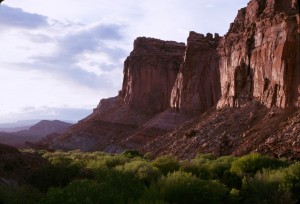
Utah’s national parks are experiencing growth in tourist revenue. They appear to be back on track a year after the government shutdown that left them closed for 12 days and caused a downslide in profits.
Bryce Canyon National Park Superintendent Jeff Bradybaugh confirmed that things are looking good at Bryce Canyon.
“Revenue from entrance fees is up slightly, as is total visitation,” Bradybaugh said. “For 2014, our visitor attendance year-to-date through the end of June was up one percent.”
Capitol Reef National Park Chief of Interpretation Lori Rome has noticed similar trends.
“In June we had 96,000 total recreational visits. The same month last year was 90,000, so we’re up by 6.6 percent,” Rome said.
Although it’s not a huge increase, it helps lay to rest concerns over the effect of the shutdown last year. Even in the surrounding communities, things seem to be looking up.
St. George Tourism Office Director Roxie Sherwin has noticed that the businesses inside and outside of Zion National Park report that visitors have been keeping them busy.
“Tourism is strong,” Sherwin said. “This year we’re pacing well ahead of last year. Every single month is tracking well ahead of last year, and last year tracked well ahead of the year before. According to the hoteliers and the businesses up in Zion, they are very high occupancy; their bookings are solid.”
A year ago things didn’t look so good. Due to the failure of passing legislation that would set apart funds for fiscal year 2014, the U.S. government was required to shut down all government functions considered unnecessary to the operation of the federal government. Unfortunately, one of the programs in Utah that was axed for the shutdown in October 2013 was the National Park Service, which takes care of the five national parks in the state: Zion, Bryce Canyon, Capitol Reef, Canyonlands and Arches.
The Utah national parks caught a break when the state of Utah reached an agreement with Secretary of the Interior Sally Jewell. The state paid the National Forest Service $1 million to open up the parks six days before the end of the shutdown, helping the parks regain some of their revenue.
As stated in a report released from the U.S. Department of the Interior, the surrounding gateway communities near the parks in Utah lost approximately $17 million in revenue because of the shutdown.
Although there was substantial loss, another report released by Jewell stated that the parks have continued to act as an “economic engine” for the federal government; she is confident that the parks will continue to be successful when looking at how they “return $10 for every dollar American taxpayers invest in the National Park Service.”
Although the National Park Service has regained visitors and is optimistic about its year so far, it’s hard to see what the future may bring.
“It’s hard to predict long-term how the shutdown may affect visitation, but prior to the shutdown … between 2008 and 2012, we’d shown a steady increase in park visitation,” Bradybaugh said.
Although things didn’t really change procedurally, the park administrations have been cautious about spending. It makes sense when looking at the number of visitors the parks get.
“We realize that we’re going to have well over a million people coming to visit the park, and so we want to make sure that our operations are solid,” Bradybaugh said. “We’re doing all the things that the visitors need in terms of safety and services and also protecting the park resources, which of course is the reason why people come to visit.”




